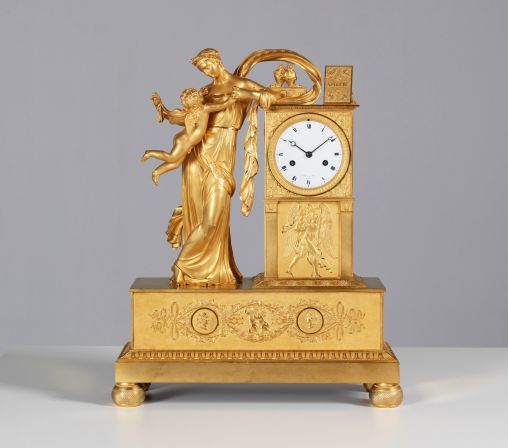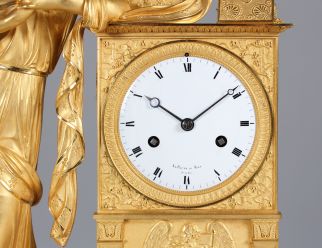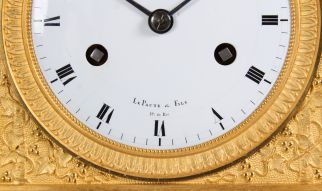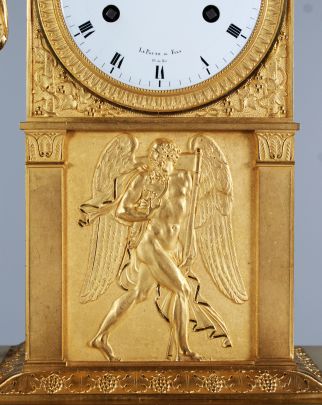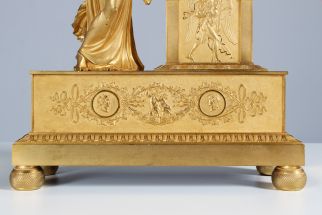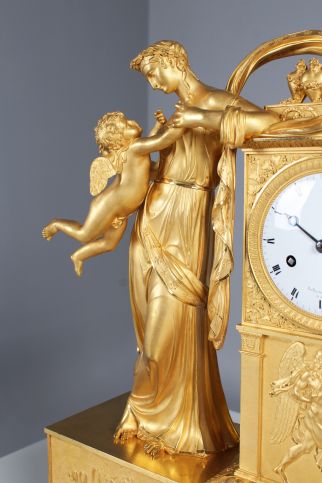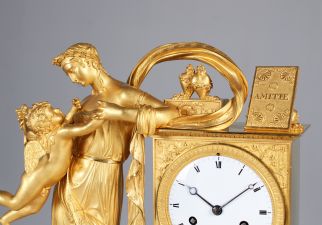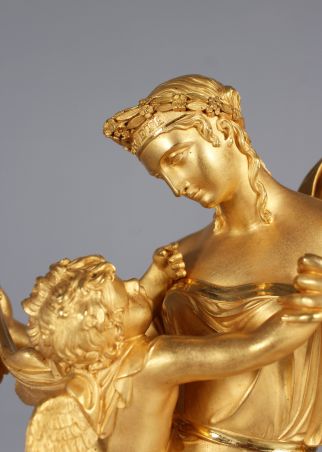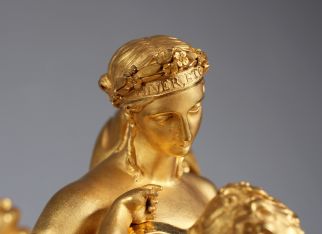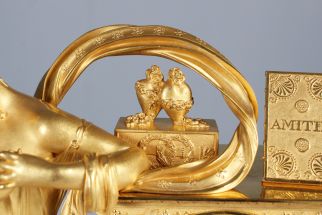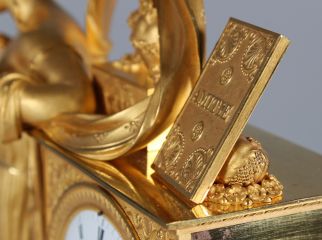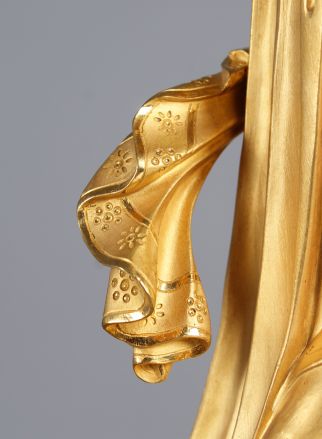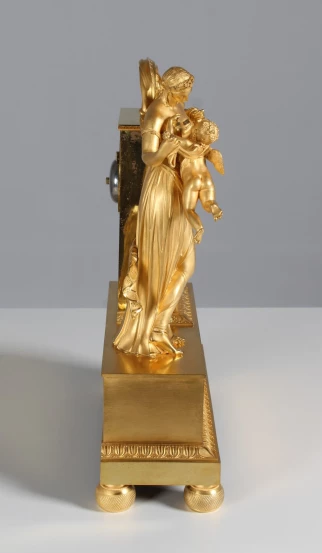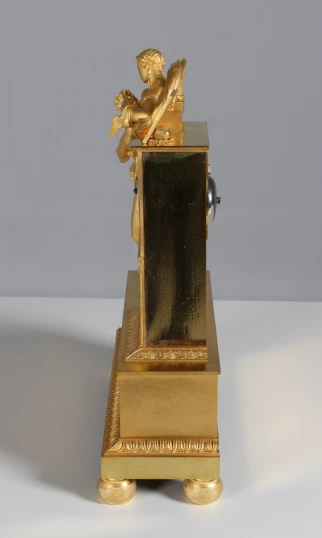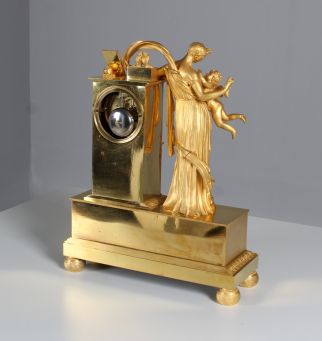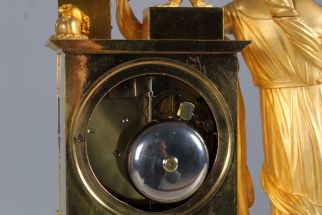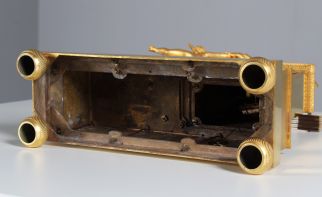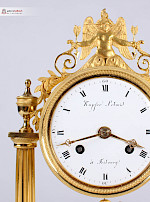Pendulum with depiction of friendship and love
Paris (Lepaute, Thomire)
fire-gilt bronze
Empire around 1815
Dimensions: H x W x D: 44 x 36 x 13 cm
French pendulum movement with eight-day duration. Thread suspension and lock disc striking movement with strike on bell on the half and full hour.
White enamel dial with Roman hour numerals and Breguet hands.
Signature: LePaute & Fils / Hrl. du Roi (Pierre-Basile Lepaute (1750 - 1843) with his son Pierre-Michel Lepaute (1785-1849); from 1811 in joint workshop).
Description:
The extremely high quality pendulum shown here takes up a profound theme: Friendship, which combines with love and can thus outlast time and death. As is typical for the era of classicism, personifications and symbols are taken from ancient mythology and art and then developed further.
The main figure is a young woman in an antique, girded garment, standing barefoot and with crossed legs next to an altar on which she is leaning with her left elbow. She gracefully bows her head towards a tempestuously approaching Cupid, grasps his right hand with her left and draws him to her bosom, the seat of the heart. The delicate ambivalence of flying towards and being held culminates in the trusting, intimate look the two cast at each other.
The young woman personifies friendship, the winged Cupid love. As a sign of their intimate union, two burning hearts appear on the altar next to the two, framed by the puffed-up shawl, which are closely bound together by a chain of flowers.
Next to them, on the altar slab, is a book with the title "Amitie" (French: amitie, friendship). The book is supported by a pomegranate, which is held by a ring of pomegranate blossoms. The plump seeds spill out of the cracked skin. Since ancient times, the pomegranate and its blossoms have been consecrated to the goddess Persephone, symbolising the underworld and death, but also life and fertility. The myrtle woven into the pomegranate flower wreath of "friendship" also has a far-reaching symbolic power: the plant was consecrated to the goddess Aphrodite, stands for virginity, and was and is therefore obligatory in the bridal wreath. Above all, it signifies love and faithfulness beyond death.
The inscription "HIVER, ETE" at the top of the young woman's headband also points to the dimension of infinity. The friendship lasts "winter and summer", i.e. also beyond death.
This is also indicated by the figure of Chronos in the relief field below the dial. The god of time is depicted as an old but muscular and athletic man with a strong beard and powerful wings - time "flies". In his left hand he holds a large scythe with which he cuts off all life. Unusually, however, he also clutches a bow with quiver and arrows in his right arm. As he strides hurriedly to the right, he looks cautiously to the left, as if he thought he was being followed. In fact, he would have every reason to do so, for the bow and arrow originally belong to Cupid, the god of love. They are his weapons feared by men and gods. For with the flaming arrows of love he strikes the hearts of men and wounds them severely. This kind of love wounds the heart, it combines passion with desire, sexuality, jealousy, pain, loss. A Cupid deprived of these weapons would be the one, ideal love that overcomes physicality and transience.
It is precisely this kind of love that we see here in the form of the now disarmed Cupid flying to the heart of friendship to join it.
For French art, the theme of the transformation of passionate love into loyal soul friendship is directly and exemplarily connected in the figure of Madame de Pompadour (1721 - 1764), who was the official mistress of the French King Louis XV for over 20 years and also one of the cleverest and most powerful women of her time. But in 1750, the love relationship with the king is transformed into a friendship relationship. In accordance with the necessary legitimisation of this change of role before court and society, she commissioned the most important artists to create allegorical sculptures.
In 1758, for example, Jean-Baptiste Pigalle created the marble group "Love embraces friendship", which can be seen as a direct model for the bronze of the pendulum shown here, especially the intimate connecting gaze of the two, but also the blossoms and the vine-covered elm trunk (left and right above the dial).
But not only the imagery and composition of the bronze group are outstanding. The fineness of the casting as well as the original fire gilding and the manifold chasing show the highest quality.
This is particularly evident in the bas-relief of Chronos: here the background is grainy chiselled, while the wings reveal each individual feather. The body is chiselled in such a way that the surface emphasises the shimmering parts of the muscles and thus appears extremely three-dimensional. As a literal highlight, individual areas, such as the edges of the fluttering cape, are highly polished and reflect the light brilliantly.
The quality of this bas-relief, which stands out only slightly from the surface and yet produces an astonishing plasticity, represents a high level of sculpture.
Although the bronze is not signed - like almost all pendulums of this period - the composition and the quality of the figures, the bronze work, the gilding and the chasing allow us to consider Pierre-Philippe Thomire (1751 - 1843) for this. The most important broncier of the Empire can be shown to have worked more frequently with the Horloges Lepaute (Lit. Augarde, pp. 352-354).
A special quality feature of the work of art is the integration of the original movement with the white enamel dial into the iconography of the bronze. Through the hour markers and hands, but also through its ticking, it embodies the unstoppable progress of time in a sensually real way. The dynamic chronos of the bas-relief underneath is a physical representation of this progression. In contrast, the dead elm tree with the vivid vine leaves reminds us of the constancy within the course of time.
Overall, this bronze pendulum, with its thoughtful and finely executed composition, is a perfect symbol of an ideal, loving friendship that transcends all time.
Worth knowing:
The Horloges of the Lepaute family form their own dynasty in Paris with outstanding workshops. They have held the honourable title of "Horloger du Roi" (Watchmaker to the King) since 1751, the reign of the French King Louis XV. This continued under Louis XVI and, after the end of the Bourbon kings with the Revolution of 1789, under Emperor Napoleon I (1805 - 1814). Pierre Basile Lepaute and his son Pierre Michel were now given the title of "Horloger de l'Empereur" (Watchmaker to the Emperor).
Even after the end of the Napoleonic Empire, they retained their privileged position in the following period of the Restoration, when the Bourbon kings were enthroned again: in 1814 they became "Horloger du Roi" for the Bourbons Louis XVIII (1814 - 1824) and Charles X (1824 - 1830).
Throughout their creative period, the watchmakers of the Lepaute family were commissioned with works not only by the royal court, but by the entire high aristocracy. In keeping with the high demands of their clients, they worked with the most important sculptors and bronciers, including P.-P. Thomire, R. Osmont, F. Vion and Clodion. Accordingly, their pendulums can be found in the world's most important castles, collections and museums.
Condition:
Excellent condition of the movement as well as the original fire gilding.
Price: 7800,- €
The price includes an expertise written and signed by Dr. Elke Niehüser. Most of the above description is taken from this comprehensive expertise.
Comparative objects can be found in the following literature:
Jean-Dominique Augarde - Les Ouvries du Temps p.351-353
H. Ottomeyer / P. Pröschel - Gilded Bronzes p. 343-346
Elke Niehüser - The French bronze clock
Tardy - Dictionaire des Horlogers Francais p. 384
Gravelot / Cochin - Iconologie par Figures (23) AMITIÉ
Article found under: Clocks
Add to shopping cartPendulum with depiction of friendship and love
Video Empire Pendule
Also interesting
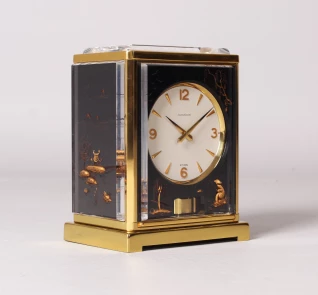
Jaeger LeCoultre - Atmos "Chinois
Switzerland
Brass, plexiglass
Year of manufacture 1965
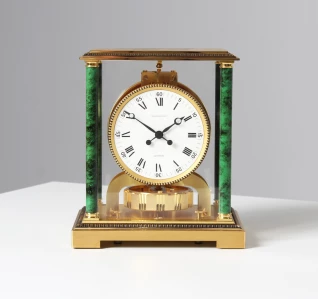
Jaeger LeCoultre - Atmos Vendome Ref. 5812
Switzerland
Brass gold plated and lacquered
Year of manufacture 1972
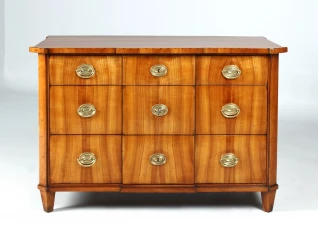
Classicist chest of drawers with central locking
Southern Germany
Cherry tree
Early 19th century
